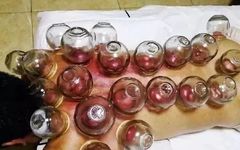Learn various Gua Sha and cupping techniques to easily master their application for treating numerous ailments.
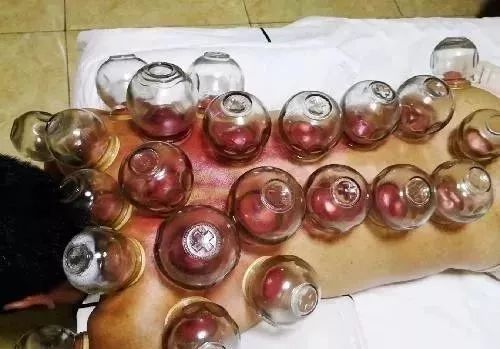
1. Wind – Repeated Cupping Loss
In Traditional Chinese Medicine (TCM), wind is considered the chief of all diseases and the foremost of the “Six Evils”. When the body is invaded by wind, it penetrates deeply into the tissues, making it extremely difficult to expel. Other methods may not be effective, but one method stands out: cupping.
The greatest benefit of cupping is its ability to draw out deep-seated wind, cold, and dampness from the body, which cannot be achieved through Gua Sha or massage. Additionally, it is simple to perform and has no side effects. This is why cupping became a global sensation during the 2016 Rio Olympics.
Many people may have experienced the phenomenon of cups falling off during cupping.
Whether using air or fire cups, the principle relies on negative pressure to draw the qi and blood around the cup to the cupping site, using positive qi and blood to expel external pathogens. However, during this process, you may notice that no matter how tightly the cup is applied, it falls off after a short while, while other cups remain in place. When reapplied, it falls off again shortly after. You might wonder why this happens.
Upon checking the cup, you find no cracks or air leaks, and the client is not underweight, so it shouldn’t be unable to hold the cup! Yet, it keeps falling off, and the location of the falling cup is relatively fixed. If you encounter this situation, it indicates that there is wind present in the muscle at the site of the cup. When you apply the cup, the wind within the muscle is also drawn out, causing the negative pressure inside the cup to decrease until it equals the atmospheric pressure outside, resulting in the cup falling off.
Therefore, you need to repeatedly apply the cup to the area where it falls off. After several repetitions, you will find that the area that was prone to losing the cup can finally hold it, indicating that the wind has been completely expelled. At this point, you should continue to leave the cup on until the skin shows a healthy color, not just a pale white before removing it.
So, what kind of individuals are likely to experience wind entering the muscles? In other words, who is likely to experience cupping loss?
If a person has worked outdoors for a long time, such as in geological exploration, herding, or engineering supervision, especially in high-altitude northern regions, even a single instance of neglecting to keep warm can lead to wind entering the muscles.
What symptoms do people affected by wind experience?
The main symptoms include blockage of the Bladder Meridian on the back, leading to heat above and cold below, with excessive sweating and heat in the upper body, mouth sores, and even elevated blood sugar, while the knees, calves, and feet feel very cold. This is typically indicative of wind invasion. Describing this condition as “heat above and cold below” is quite appropriate! Western medicine cannot, and TCM methods such as Gua Sha, massage, moxibustion, acupuncture, and herbs cannot expel wind either, only cupping can!!!
2. Cold – Black and Purple Cup Marks
If the cups are left on for more than 20 minutes and the marks are black and purple, it indicates cold invasion. This condition is quite common, especially among younger individuals; those with abundant qi and blood are more likely to show black and purple cup marks when exposed to cold.
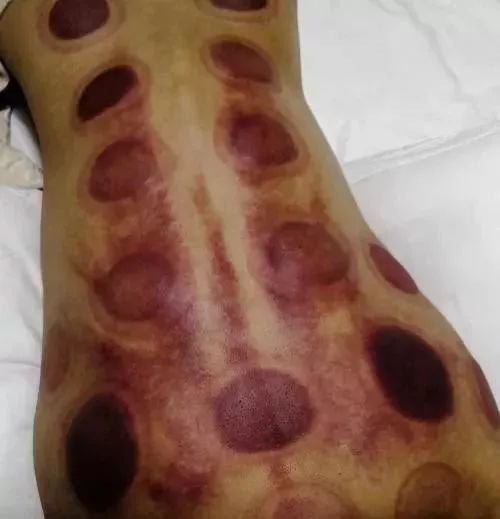
This is a photo shared by a young man in my social circle. He is in his twenties and often engages in outdoor activities such as skiing, diving, sailing, swimming, horseback riding, mountaineering, and racing… he enjoys all outdoor activities. Because of this, if he does not pay attention to keeping warm, he is very susceptible to cold invasion.
When a person is affected by cold, they will feel pain all over, especially in the back.Generally, if a person catches a cold, as long as they have a fever and sweat, the cold is usually expelled. However, some individuals, for various reasons, do not completely expel the cold in time, leading to the cold remaining trapped in the skin’s pores. Therefore, using the word “pain” to describe the sensation of cold is most appropriate!
3. Dampness – Blisters
Cupping can often draw out blisters, indicating that the individual has a significant amount of dampness in their body. Those with heavy dampness will feel a sense of heaviness in their body; if I were to describe it in one word, it would be “lazy”; and in another word, “overweight”!
Where do people typically have heavy dampness?
Generally, southern individuals have more dampness than those in the north. Even if you live in the north, if you were born and spent your youth in the south, you are also likely to have heavy dampness.
Additionally, from a professional perspective, those who spend long hours in the office without exercising, frequently use air conditioning, or work with water are also prone to heavy dampness.
From a dietary perspective, those who love eating rice, pork, and beer tend to have heavy dampness.
Individuals with heavy dampness, if the cups are left on for more than 20 minutes, will draw out blisters. Remember, even if the cups are left on for more than 20 minutes, some areas may produce blisters while others do not, indicating that it is not just the duration of cupping that causes blisters, but that dampness is indeed present in that area. Take a look at the images!


In such cases, it indicates that there is significant dampness in the body. As long as the blisters are punctured, the dampness will be expelled, and the body will immediately feel relieved. Not only will the person become slimmer, but the “lazy” feeling will also disappear immediately.
Of course, dampness is often accompanied by cold dampness, as shown in the photo below:
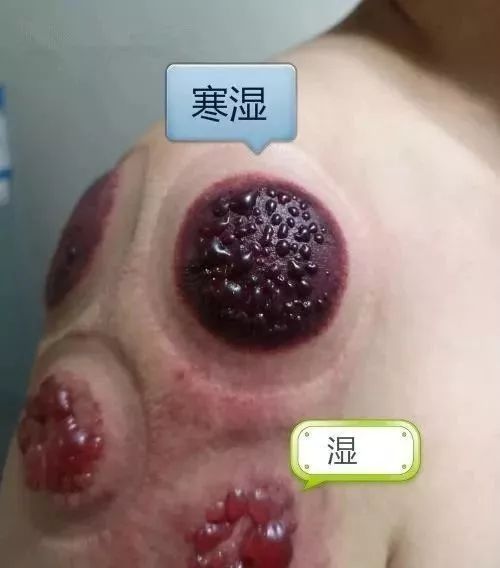
This is my own condition; the black pomegranate indicates cold dampness, while the pomegranate indicates pure dampness. Of course, there are also cases where the blisters contain yellow fluid, which indicates damp-heat, but this is less common.
In summary, the main reasons for repeated cupping loss are wind invasion; black cup marks without blisters indicate cold invasion; and blisters indicate dampness, with black blisters indicating cold dampness and yellow blisters indicating damp-heat. Of course, a person may simultaneously experience wind, cold, and dampness, but there will always be one predominant condition. Just remember these points, and you will become proficient in cupping techniques in the future! Expelling deep-seated wind, cold, and dampness is best achieved through cupping! How about that? It’s all valuable information!
Further Reading –
Cupping Techniques: Retaining, Flashing, and Sliding (with Learning Videos)
Retaining Cupping Technique
The retaining cupping technique is the most commonly used method in cupping, also known as the sitting cupping method, which involves placing the cup on the skin and leaving it for a period of time. The retention time is typically 5 to 20 minutes, depending on the patient’s condition and the season. Generally, in summer and on thinner skin, the retention time should not be too long.
There are two forms of the retaining cupping technique:
One is the single cup method, which uses a single cup and is suitable for small areas of pathology.
The other is the multiple cup method, which uses multiple cups simultaneously, also known as the排罐法 (排罐法). The cups are generally arranged along the muscle bundles, nerves, or meridian pathways. If the body is strong, the cups can be placed closely together; if the body is weak, the cups should be spaced further apart. This method is suitable for broader areas of pathology.
Flashing Cupping Technique
The flashing cupping technique involves holding a cup in one hand while using tweezers to hold a cotton ball soaked in alcohol, igniting it, and then quickly placing the cup on the affected area, followed by immediate removal. This process is repeated several times until the skin shows redness and bruising. This method is suitable for areas with more relaxed muscles.
Sliding Cupping Technique
The sliding cupping technique, also known as the pushing or pulling cupping method, involves selecting a cup with a larger opening, thicker walls, and a smooth, undamaged surface. A thin layer of lubricant, such as liquid paraffin, petroleum jelly, or other plant oils, is applied to the area to be cupped.
After applying the cup using the flashing or throwing method, hold the bottom of the cup and tilt it slightly to slide it back and forth. The direction can be forward, backward, left, right, or even in a circular motion. Repeat several times until the skin shows redness and bruising. This method is suitable for large, flat areas of the body with thick, firm muscles, such as the back and waist.
Some Precautions for Cupping
First, which comes first: cupping or bathing?
Many people who love to bathe often say, “Cupping and bathing are both essential.” Indeed, the warm bathwater and warm cupping, whether bathing before or after cupping, sounds comfortable. However, this order is crucial; you can bathe before cupping, but you must not bathe immediately after cupping.
After cupping, the skin is in a relaxed state, and bathing, especially with cold water, can easily damage or inflame the skin. If cold water is used, it can further irritate the skin and lead to chills, so do not bathe immediately after cupping.
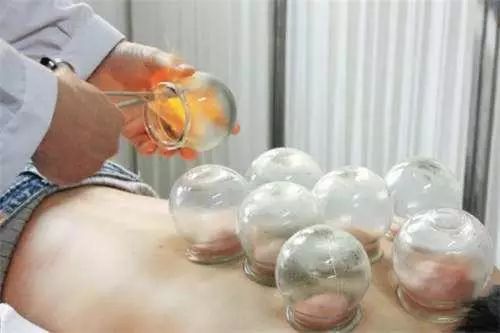
Second, is longer cupping always better?
Many people believe that cupping should last at least half an hour, and some think that blisters must form to demonstrate the effectiveness of cupping, especially among older individuals. But is longer cupping really better?
The duration of cupping varies based on the size, material, and negative pressure of the cup. However, it is generally advisable to keep the cupping duration from the moment the fire is extinguished to removal within ten minutes. The primary principle of cupping is negative pressure, not duration. If the cupping time is too long under high negative pressure until blisters form, it can damage the skin and potentially lead to skin infections.
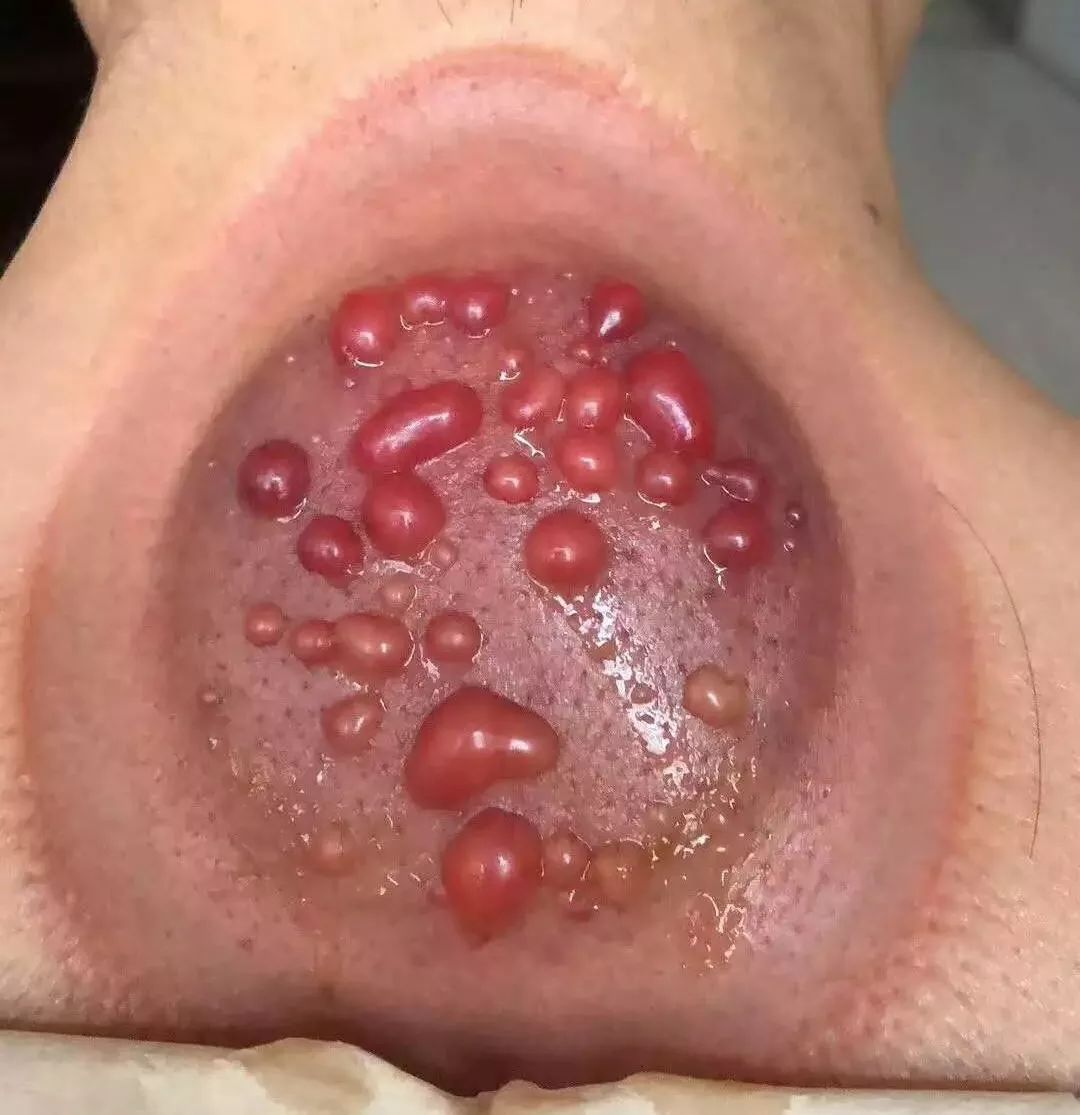
Third, can the same area be cupped repeatedly?
It is not effective to cup the same area twice in a row; repeating cupping on the same spot may not yield results. While it is possible to cup the entire body for comprehensive treatment, repeatedly cupping the same area can lead to redness, swelling, and damage to the skin, which is counterproductive.

■ If you like it, feel free to give a thumbs up!

